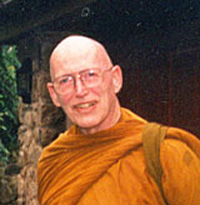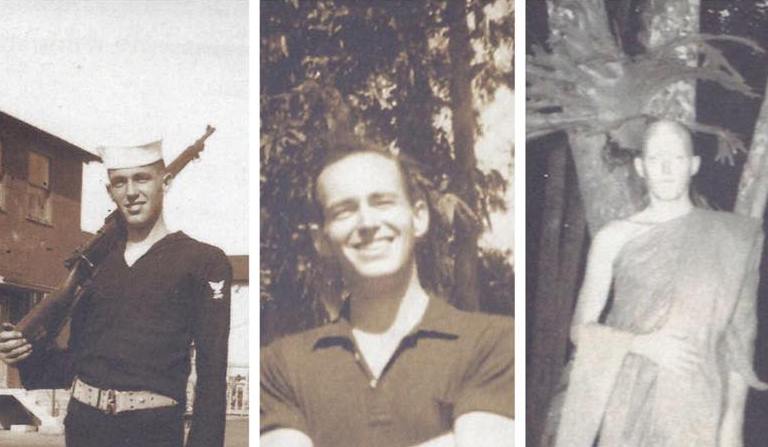
Ajahn Sumedho was abbot of Amaravati Buddhist Centre and seniormost Western disciple of the late Thai meditation master Ajahn Chah. Amaravati is affiliated with the Forest Sangha: a world-wide community following Chah's Thai Forest tradition. Sumedho has worked closely with lay organisations, notably the English Sangha Trust and with his disciples to set up a British Theravadin monastic order. This order now numbers 60 monks and nuns over several monasteries.
Ajahn Sumedho was born as Robert Jackman in Seattle in 1934. He served as a medic in the US Navy in the Korean War, during which visits to Japan awakened an interest in Asian studies, an interest that he pursued after leaving the Navy and enrolling at the University of California in Berkeley. This was succeeded by voluntary service in the Peace Corps in Sabah, Malaysia, 1964-66. However, still searching for inner peace, he visited monasteries in Bangkok but ended up travelling on impulse to North East Thailand where at Wat Saket in Nong Khai he became a novice monk (samanera), in 1966, and a bhikkhu in 1967.

The young Bhikkhu Sumedho was inspired to take on training under Ven. Ajahn Chah in Wat Pah Pong, a forest monastery near Ubon, about 450 kilometres/275 miles south-east of Nong Khai. He felt drawn to Ajahn Chah’s more exacting standard of training, which he felt would build greater self-discipline. As he frequently recounts, it made him aware of his emotional immaturity and provided the means to take personal responsibility for the suffering that his mind created. Out of gratitude for the ‘Dhamma-parenting’ of Ajahn Chah, after his fifth rains season as a bhikkhu, Ven. Sumedho offered his life to serve his teacher. This led him to accept the invitation to start a monastery for Westerners (Wat Pah Nanachat) close to Wat Pah Pong in 1975. His sojourn as abbot there was relatively brief however: when Ajahn Sumedho1 stopped in London for a few days on returning from a family visit to California in 1976, he stayed at the Hampstead Buddhist Vihara and there met George Sharp, the chairman of the English Sangha Trust – a charity set up in 1956 to support the establishment of a Bhikkhu- Sangha in the West. Their meeting led to Mr. Sharp travelling to Thailand to visit Ajahn Chah and invite him and Ajahn Sumedho to London in 1977. With Ajahn Chah’s permission and blessing, Ajahn Sumedho stayed on at the vihara, where he was joined by Ajahn Khemadhammo, Ven. Anando and Ven. Viradhammo.
Ajahn Chah had emphasized that, even though they lived in London, the group of bhikkhus should go out on the streets on a daily alms- round: both to let people see them and to keep the bhikkhus tuned in to the principle of alms-mendicancy. What no one expected was that this would result in the sangha being offered a sizeable tract of woodland in West Sussex. But a chance encounter with a jogger crossing Hampstead Heath in 1978 resulted in just that – with the enticing possibility that the sangha could live in an environment more suited to their training. However, as the woodland had no accommodation facilities, and as the legal process of transferring the ownership to the English Sangha Trust was protracted, it wasn’t until June 1979 that, with the chance sale of the nearby Chithurst House, the move could take place.
As the house was derelict, it required the community to commit to a very full schedule of work to make it livable. But Ajahn Chah, visiting Britain in June 1979, spent a week at Chithurst and gave it his blessing. Ajahn Sumedho, realizing that, at this time, there would be no possibility for any of the community to practise solitary dwelling (ka¯yaviveka), decided that the name of the monastery, punning on ‘Chithurst,’ should be ‘Cittaviveka’: ‘the mind that has withdrawn from corruptions’. It was the first forest monastery in Britain, and in 1981, the first permanent ordination precinct (si¯ma¯) in the West was established there by Ven. Ananda Maitreya Mahana¯yaka Thera of Sri Lanka.
At that time, Ajahn Sumedho had just recently been given the authority to grant Admission to the Bhikkhu-Sangha (upasampada¯), the formally established si¯ma¯ meant that he could begin to induct men into the Bhikkhu-Sangha, which he first did in July 1981. He followed that up by requesting and obtaining permission to give the Going-Forth (pabbajja¯) to women, which he began doing in 1983. This meant that the Sangha was now properly established in Britain.
Prior to Ajahn Sumedho’s arrival in Hampstead, London in 1977, the presentation of Theravada had predominantly been of a scholastic nature, interspersed with formal meditation instructions. No one had presented Theravada, let alone monastic training, as a way of life and support for the realization of nibba¯na. Not only that, but the training that Ajahn Sumedho spoke of and embodied was earthy, and gave rise to deep insights into the Western mind. It gave rise to ease, contentment and a surprising degree of flexibility and good humour. And as he and his growing number of followers demonstrated, it wasn’t just theory – this way of life, drawing close to the lifestyle of the early Sangha, could be lived in the contemporary West.
Through accepting many invitations to teach, and adopting the ten-day retreat form popularized by U Ba Khin and Goenka-ji, Ajahn Sumedho soon became a very popular teacher in the West. With popularity came requests to start other monasteries where his monastic disciples could live, practise and be a support to local lay communities. The first of these branch monasteries, now called Aruna Ratanagiri, was established at Harnham, in Northumberland, in 1981. Within a couple of years, supporters in Devon also set up a residence for bhikkhus; this led to the subsequent establishment of Hartridge Buddhist Monastery. Requests for monasteries in New Zealand and Switzerland soon followed; and in the 1990s monasteries were also established in Italy and California. However before these later foundations had come to be, Ajahn Sumedho had taken a step to realize his own vision of a setting for the practice of Dhamma. Sensing the limitations of Cittaviveka, and acknowledging both the growth of the nuns’ sangha and the eagerness of laypeople to hear talks, spend time in a monastery and go on retreats, Ajahn Sumedho was, by the early 1980s, on the lookout for a property in Britain that could provide suitable facilities. In 1984, a couple of close supporters found something suitable: a school that had also been a place to evacuate children to during the Second World War, north of London and near to Hemel Hempstead. It was fairly basic – a cluster of long single-story wooden buildings around a central playground with a few acres of meadow out back. However, St. Margaret’s School was up for sale at a bargain price, and so – ‘Amaravati’ (‘the Deathless Realm’) was born.
From August 1984 until his retirement as abbot in November 2010, Ajahn Sumedho was based at Amaravati. It was here that he attempted something new in terms of the Forest Tradition – a monastery that was envisioned as offering laypeople with a retreat facility, and a venue for festivals and public talks. It remains as Ajahn Sumedho’s offering to society as a place for teaching, for meditation and for family occasions.
Ajahn Sucitto
Cittaviveka
|



Return to Singapore DharmaNet